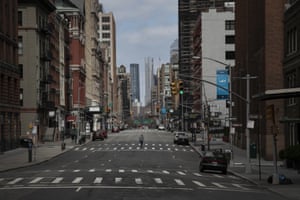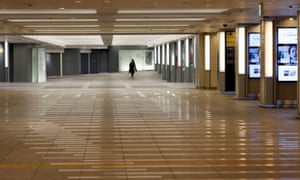The streets lie silent, the skies are clear, as office buildings
reflect our empty cities. Coronavirus has brought with it the same eerie
scenes that have long haunted the modern imagination
The
end of everything we took for normal has a dire aesthetic fascination.
The streets lie silent and still under unnaturally clean skies. A lone
walker stares into a deserted bookshop. Office buildings, once vulgar,
fulfil their true potential as sets for a sci-fi nightmare, glassily
reflecting the empty city. While I do not want to in any way downplay
the tragedy that has left thousands dead and will kill thousands more,
there has been one eerie byproduct: the apocalyptic beauty of lockdown
Britain.
Take a walk through quiet streets for your daily exercise and you come across vistas sci-fi has spent more than a century preparing us for. A main road so still you can stand in the middle of it, among the squatting pigeons. A row of expensive shops all closed and dark midweek. Such scenes of The End have haunted the modern imagination since HG Wells described the abandoned streets of the imperial metropolis and devastated Surrey in The War of the Worlds. We’ve all absorbed these visions of apocalyptic Britain, generation after generation, from the 1970s TV chiller Survivors to Danny Boyle’s uncannily convincing dawn photography of an emptied landscape in the film 28 Days Later. Surely we can be forgiven a frisson of macabre awe at seeing all these fantasies become real.

Take a walk through quiet streets for your daily exercise and you come across vistas sci-fi has spent more than a century preparing us for. A main road so still you can stand in the middle of it, among the squatting pigeons. A row of expensive shops all closed and dark midweek. Such scenes of The End have haunted the modern imagination since HG Wells described the abandoned streets of the imperial metropolis and devastated Surrey in The War of the Worlds. We’ve all absorbed these visions of apocalyptic Britain, generation after generation, from the 1970s TV chiller Survivors to Danny Boyle’s uncannily convincing dawn photography of an emptied landscape in the film 28 Days Later. Surely we can be forgiven a frisson of macabre awe at seeing all these fantasies become real.


The latest news images reveal a further surrealism: the lockdown in decay. More and bigger queues, as DIY superstores reopen. It’s rumoured garden centres will be next. As Ballard would say, the middle class must have its illusions even in the apocalypse. In truth, looking at images of gathering crowds, I feel a pang of loss. At least the early days of the lockdown were absolute. At least they were sublime.

You can still find the sudden silence in the heart of the city. There are moments when no other walkers are about, no cars come by, and empty workplaces tower above in brutalist disregard. It’s worth seeking out such ground zeros of total lockdown. In the centre of the city in the day, you can appreciate the terrible beauty of the day the earth stood still. At least it will be something to remember in the sad convalescent years ahead.

No comments:
Post a Comment